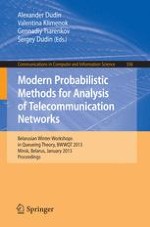2013 | Buch
Modern Probabilistic Methods for Analysis of Telecommunication Networks
Belarusian Winter Workshops in Queueing Theory, BWWQT 2013, Minsk, Belarus, January 28-31, 2013. Proceedings
herausgegeben von: Alexander Dudin, Valentina Klimenok, Gennadiy Tsarenkov, Sergey Dudin
Verlag: Springer Berlin Heidelberg
Buchreihe : Communications in Computer and Information Science
